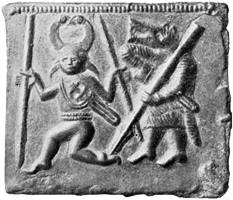
This page created 18 October 2014, and last modified: 29 October (Frankfurt fragment image added)

One of the auxilia palatina units in the Magister Peditum's infantry roster is called the Honoriani Marcomanni iuniores. Its shield pattern in various manuscripts, under the label Marcomanni iuniores, is as shown below:

The shield pattern is red, and charged with a white (yellow in B) version of the twin-headed zoomorphic motif that is extremely common in the Notitia (over a dozen examples), especially amongst auxilia palatina. In addition to its numerous appearances in the Notitia, the twin-headed zoomorphic motif is known from a range of sources in northern Europe, such as on the ca. 6th century Torslunda bronze die from Sweden shown below:

While it is evident that the patterns for many of the western auxilia platina units may been shifted from their proper place as the distribution part of the Notitia was updated, the fact that the Honoriani Marcomanni seniores and the preceding unit in the Magister Peditum's roster, the similarly named Honoriani Marcomanni seniores, have similar patterns (if not colours) would seem to indicate that these patterns may well be in their correct places; this is reinforced by the similarities in the patterns of the neighbouring units, the also similarly-named Honoriani Atecotti seniores and Honoriani Atecotti iuniores.
Neither the Honoriani Marcomanni seniores nor the Honoriani Marcomanni iuniores is assigned to a field army, although the Magister Peditum's Italian command does list a plain Marcommani, whose position second from last in the list implies a recent addition to the command. Whether this represents the Honoriani Marcomanni seniores or the iuniores unit is unknown; either is possible (of course, it could also represent a totally different unit, perhaps one newly raised, or even an amalgamation of the two, although both these possibilities would seem to be less likely than the single unit option).
The name Marcomanni comes from the Germanic tribe of the same name, and which is believed to mean "the frontiers ('march') people ('man')"; they were a sub-branch of the Suevi (Swabians). They fought some major conflicts against the Romans, especially under Marcus Aurelius in the 2nd century and in the early 5th century: the period during which the Notitia was being amended. They may have formed a portion of the Suevi that managed to penetrate across the Rhine in conjunction with many Alans and Vandals, and settle in northwest Spain, founding an independent kingdom that lasted over 170 years until absorbed by the Spanish Visigoths. Only two other units are so-named in the Notita: the Equites Marcomanni, a cavalry vexillationes comitatenses assigned to the Comes Africae, and whose shield pattern shows a single draco, rather than a two-headed version; and the Gentes Marcomannorum, under the Dux Pannoniae primae et Norici ripensis, which appears to be the only example in the Notitia of a unit called gentes ("people") under the direct command of a military Dux.
The name Honoriani refers to the emperor Honorius, who succeeded his father Theodosius I in 395, around the time the Notitia was first compiled. Note that Honorius had however, been declared co-Augustus two years earlier, at the age of 7, so the presence of units bearing the name Honorius does not therefore prove they must have been entered into the document so-named at 395 at the earliest. Nonetheless, the presence of large numbers of units named after Honorius in the western half of the Notitia, compared to very few in the east, is one of the clearest indications the eastern portion was not amended much, or even at all, after the death of Theodosius, while the western half was extensively updated.

Return to the Notitia alphabetical unit list page.
Return to my Notitia index page.